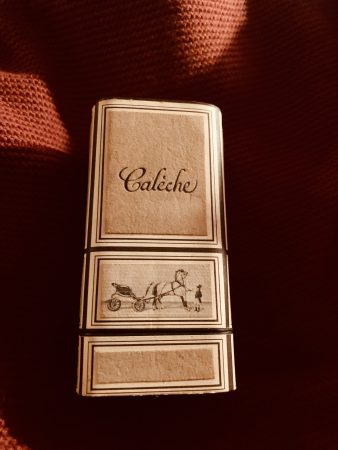
Vintage Hermès Calèche from Ida’s collection
“Un parfum doit avant tout sent bon (a perfume should first and foremost smell good).” ~ Guy Robert, Master Perfumer

Guy Robert composed Hermès Calèche in 1961 (courtesy of Michael Edwards Fragrances of the World)
Who would wish to contradict Le Maître? I suspect that today there are many who might feel so inclined; fragrance has come a long way since the 1960s – and perfume as performance art as well. Beauty and function may remain in the eye and nostril of the beholder, but personally, I prefer to smell so ravishing that I might tempt a famished dog off a meat wagon. Seduction assumes many guises, and few charms endure over the passage of time; I’m grateful to have retained my voice, a penetrating gaze, and the capacity for smelling delicious. In the infamous words of Mrs. Meister: “You don’t get to have it all – and you don’t get to keep it all.” One may still smell as if you’ve got it all, however: enter vintage Calèche d’Hermès by the master Guy Robert, stage left.
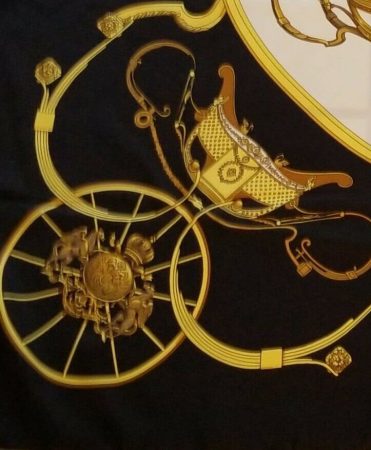
Detail of Michelyn’s Hermès scarf circa 1980s which was issued in 1974 (Artist Phillipe Ledoux)
Hermès Calèche appeared upon the scene one year after Robert’s famous Madame Rochas – a perfume I first encountered at 14, when a large gathering of European camp counselors with whom I associated wafted it with aromatic abandon. Even though the majority of them were fresh-faced and wholesome, Madame Rochas bathed them in a glamour which I envied. While Madame Rochas was an approachable, fizzy, soapy aldehydic floral, Calèche was not. Not quite. There are many similarities between them, but Calèche is the more aloof, carelessly elegant and unstoppable older sister of the two. On horseback, enveloped in a studied déshabille, brilliantly-hued Hermès carré scarf flapping in the wind as she gallops off to heaven knows where. Imagine a youthful, accomplished equestrienne Jacqueline Bouvier Kennedy, and you’re moving in the right direction.
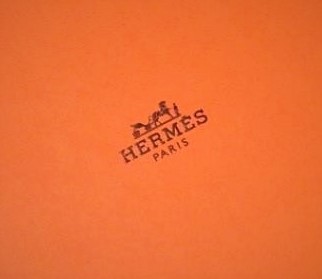
Detail of Michelyn’s Hermès scarf box
What exactly is a calèche? Its meaning is dual fold: either a hooped silk bonnet worn by women in the late 18th C. (also known as a calash) which enabled them to appear fashionable without disturbing their coiffure – or a light, low-wheeled (1-4 horses) horse driven carriage of the same period. The Calèche logo was adopted in 1945 and designed by Alfred de Dreux to honor the establishment of quality wrought bridles and harnesses created for the carriage industry in 1873 by Thierry Hermès. Up until very recently, in parts of Québec and Montreal – one might still have ridden in a calèche; it had been a popular tourist attraction.
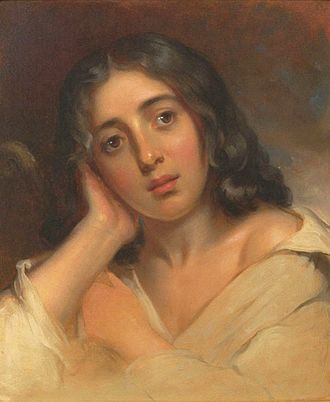
Portrait of George_Sand by Thomas Sully,1826
Calèche was among Hermès’ first forays into feminine fragrance: an aldehydic floral chypre, a particular genre which appealed to perfumer Guy Robert (Doblis, Madame Rochas, Gucci No.1, Amouage Gold Man and Woman, Dioressence), and one which he revisited brilliantly throughout his career. My first impressions of its name conjure a wildly cantering coach in which famed male-costumed writer George Sand (aka Amantine-Lucile-Aurore Dudevant, née Dupin) most hastily (and purportedly unsatisfyingly) coupled with the rather rude Prosper Mérimée (well-known as the author of the novella Carmen, which inspired Bizet’s opera of the same name!). An unabashed romantic (albeit quite the force for social change), Mme. Sand advised all and sundry to “try to keep your soul young and quivering right up to old age.” Sound advice, despite her bent for maternalistic erotic attachment to some of the more talented (and needy) men of her age – including pouty author and poet Alfred de Musset and the ill-fated genius Frédéric Chopin. I can never gaze at the Hermès logo without envisioning the above scenario in a runaway carriage.
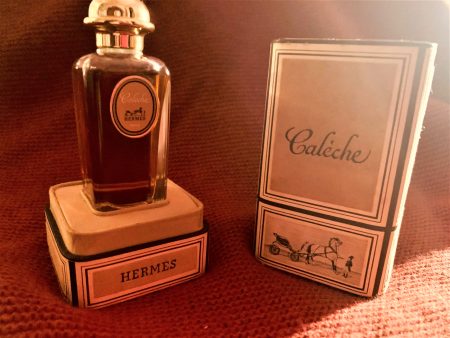
Photo by Ida©
For me, Hermès Calèche from 1961 wears two faces. One is that of a youthful Jacqueline Bouvier Kennedy: impossibly elegant from day one, astride one of her many horses. This visage is one of noblesse oblige, an aristocratic coolness and suavity where one’s taste is never in question, and decorum is exhibited everywhere – barring the unfettered freedom which equine companionship affords (as long as it doesn’t involve dressage, steeple-chasing, or other competition). Calèche bears the profile of sporty nobility which has made it a favorite and signature fragrance with patrician folk around the globe. The other aspect is mirror-opposite, as it happens: it coexists with my first true association of the perfume with an individual. In 1977 when I entered the Boston Conservatory of Music, I became very close with an unpretentious natural beauty studying for her Master’s – the marvelous Adele from Seattle, a lyric coloratura who wafted nothing but Calèche. Adele was a Norwegian blonde who needed no other embellishment; she’d had a classic old-fashioned Nordic wedding before moving East to further her musical education while dragging her carpenter husband in tow. She was a walking and singing study in contradictions – most frequently dressed in overalls and T shirts, singing conflicting repertoire which ranged from Gregorian chant to ultra-contemporary, experimental composers. Her guileless freshness and immediacy was echoed in her fragrance: nothing short of a cooling breeze on a sweltering day, sans perspiration while the rest of us simmered in our own effluvia. Adele was unflappable, funny and gracious to a fault – and whenever I wear her perfume it rekindles the fragrance of our friendship.
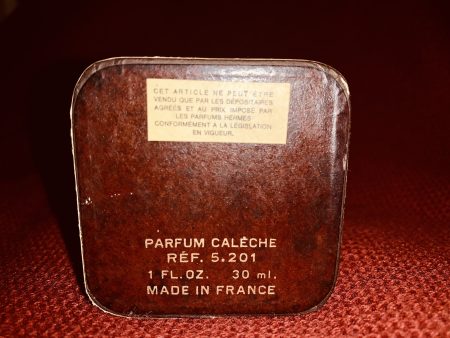
photo by Ida©
Hermès Calèche today has weathered reformulation, perhaps most effectively in the Soie de Parfum version – and it smells more linear, with less development in general: flatter, brasher and less subtle. If you’ve never experienced the original, you won’t have a reference with which to compare it, but the current Calèche still smells better than many other contemporary aldehydic chypres. My well-preserved vintage from the early ‘60s flaunts crystalline, kaleidoscopic aldehydes in concert with gorgeous citruses; its heart a seamless concatenation of noble blossoms which makes your senses rejoice. Jasmine, rose, muguet, orange blossom, ylang-ylang and gardenia are too beautiful by half, and the whisper of frankincense is perfectly rounded by the dusky loveliness of cypress and sandalwood, vetiver, amber, musk and tonka. There is the barest suedelike insinuation of leather in its drydown, not as prominent as in M. Robert’s 1955 Doblis.
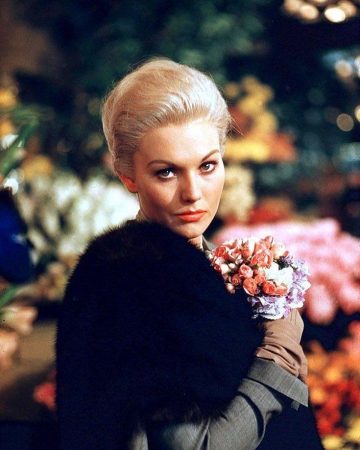
Kim Novack in Hitchcock’s Vertigo 1958
Critics of Hermès Calèche may decry the fragrance as soapy, powdery, and out of fashion. Perhaps one day people smelling our 2020s’ musky, powdery gourmand perfumes may feel similarly; only time will tell. Indisputably, the distant poise of a Kim Novak in Hitchcock’s 1958 film Vertigo will always take our breath away: timelessly chic, effortlessly refined and imbued with subtle magnetism. Vintage Calèche is much like that; it may require one to take time to become acquainted before you fall under her spell. Exquisite style, fine design never lose their lustre.
Notes: aldehydes, bergamot, lemon, neroli, cypress, jasmine, rose, orange blossom, gardenia, lily of the valley, ylang-ylang, olibanum (frankincense), vetiver, sandalwood, amber, tonka, musk
Review based upon bottles from my own collection. My nose is my own…
Ida Meister, Deputy and Natural Perfumery Editor
Follow us on Instagram @cafleurebonofficial @idameister
